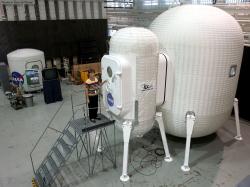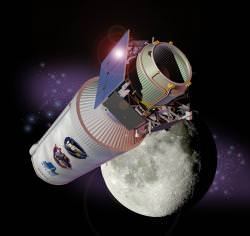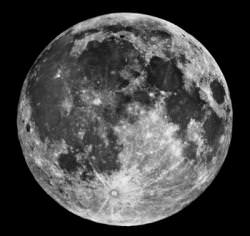 For the upcoming lunar return missions, the astronauts will be staying on the surface of the Moon far longer than they did during the Apollo. They’ll need someplace safe to live.
For the upcoming lunar return missions, the astronauts will be staying on the surface of the Moon far longer than they did during the Apollo. They’ll need someplace safe to live.
Continue reading “NASA Reveals a Sample Lunar Base”
New Views of LCROSS the Moon Smasher
 NASA artists have released new images of the Lunar CRater Observation and Sensing Satellite (LCROSS) mission. This is a secondary payload that will travel to the Moon with the Lunar Reconnaissance Orbiter. Remember the Deep Impact mission, which smashed a probe into an asteroid? Same thing, except this time the target is the Moon.
NASA artists have released new images of the Lunar CRater Observation and Sensing Satellite (LCROSS) mission. This is a secondary payload that will travel to the Moon with the Lunar Reconnaissance Orbiter. Remember the Deep Impact mission, which smashed a probe into an asteroid? Same thing, except this time the target is the Moon.
Continue reading “New Views of LCROSS the Moon Smasher”
Podcast: Where Does the Moon Come From?
 We take the Moon for granted, but its effect on the Earth is very important; possibly even critical for the formation of life. But where did it come from? Did the Earth and Moon form together? Or did the Earth capture a wayward Moon? Or was there a more catastrophic cause to this lunar mystery?
We take the Moon for granted, but its effect on the Earth is very important; possibly even critical for the formation of life. But where did it come from? Did the Earth and Moon form together? Or did the Earth capture a wayward Moon? Or was there a more catastrophic cause to this lunar mystery?
Continue reading “Podcast: Where Does the Moon Come From?”
NASA Announces Long Term Plans for the Moon
NASA announced new details about its lunar ambitions today, providing details about other nations will get involved in a return to the Moon, and the concept of a future lunar base. The Global Exploration Strategy involved 1,000 people from 14 space agencies, non-governmental agencies, and commercial companies. The Lunar Architecture Team decided that the best spot for a permanent lunar base would be at one of the Moon’s poles, which is bathed in eternal sunlight.
Continue reading “NASA Announces Long Term Plans for the Moon”
No Ice at the Moon’s Southern Pole
A new radar survey of the Moon’s southern pole has cast doubt on the hope that there might be accessible deposits of water ice in permanently dark craters. This new survey, performed with the Arecibo Observatory in Puerto Rico, found elevated hydrogen levels in regions of bright sunlight – not just inside the shadowed walls of craters. It seems that scattered rocks associated with impact craters have given previous instruments a false reading.
Continue reading “No Ice at the Moon’s Southern Pole”
Gardening for the Moon
When astronauts return to the Moon and visit Mars in the coming decades, they’ll want to bring as little as possible from Earth. That means living off the land wherever possible. Wouldn’t it be great if they could grow their own food? Researchers from Texas A&M University have grown lettuce in special cylinders that provide the plants everything they need to grow – but in a very low pressure environment.
Continue reading “Gardening for the Moon”
SMART-1 Ends in a Flash and Puff of Dust
When SMART-1 ended its mission by crashing into the Moon on Semptember 3, telescopes around the world were watching. A newly released series of images comes from the Canada-France-Hawaii Telescope, which shows the crash site before and after impact. The telescope captured images every 15 seconds, and detected the flash of impact, and the following dust cloud that lasted about 75 seconds.
Continue reading “SMART-1 Ends in a Flash and Puff of Dust”
SMART-1 Smashed into the Moon
ESA’s SMART-1 spacecraft ended its productive mission on September 3, 2006 when it crashed into the lunar soil in the “Lake of Excellence” region of the Moon. The impact took place on the near side of the Moon, in full view of Earth and space-based telescopes; even amateurs captured a tiny flash in their telescopes as the spacecraft obliterated, and carved out a small crater. This final act of science will hopefully give researchers some insights into the minerals that lie underneath the lunar surface, which were briefly excavated by the impact.
Continue reading “SMART-1 Smashed into the Moon”
Linking the Formation of the Earth and Moon
Did the Earth capture the Moon with its gravity, did they form together in the early Solar System, or did the Moon form when a Mars-sized object smashed into the Earth. New data from ESA’s SMART-1 spacecraft has turned up deposits of calcium on the lunar surface. By measuring these minerals, as well as aluminium, magnesium and silicon, scientists can better map out the composition of the Moon, and predict what kind of impact might have happened.
Continue reading “Linking the Formation of the Earth and Moon”
SMART-1’s Final Days
After 16 months of successful observations, ESA’s SMART-1 is about to make its final contribution to lunar science. On September 3, 2006, it’ll crash into the Moon in full view of Earth- and space-based telescopes, giving astronomers a glimpse of what’s underneath the surface. In its final orbits, the spacecraft will be flying so low that it might crash into a hill on a previous pass, giving different Earth-based telescopes a better view. The final crater is expected to be 3-10 metres (10-33 feet) wide and 1 metre (3 feet) deep.
Continue reading “SMART-1’s Final Days”
